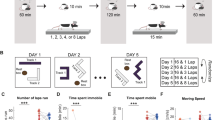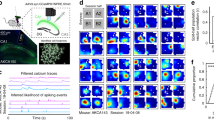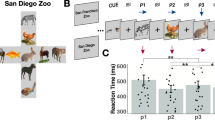Abstract
Hippocampal replay has been hypothesized to underlie memory consolidation and navigational planning, yet the involvement of grid cells in replay is unknown. During replay we found grid cells to be spatially coherent with place cells, encoding locations 11 ms delayed relative to the hippocampus, with directionally modulated grid cells and forward replay exhibiting the greatest coherence with the CA1 area of the hippocampus. This suggests grid cells are engaged during the consolidation of spatial memories to the neocortex.
This is a preview of subscription content, access via your institution
Access options
Subscribe to this journal
Receive 12 print issues and online access
$209.00 per year
only $17.42 per issue
Buy this article
- Purchase on Springer Link
- Instant access to full article PDF
Prices may be subject to local taxes which are calculated during checkout



Similar content being viewed by others
References
O'Keefe, J. & Nadel, L. The Hippocampus as a Cognitive Map (Claredon, Oxford, 1978).
Hafting, T., Fyhn, M., Molden, S., Moser, M.B. & Moser, E.I. Nature 436, 801–806 (2005).
McNaughton, B.L., Battaglia, F.P., Jensen, O., Moser, E.I. & Moser, M.B. Rev. Neurosci. 7, 663–678 (2006).
Bush, D., Barry, C., Manson, D. & Burgess, N. Neuron 87, 507–520 (2015).
Wilson, M.A. & McNaughton, B.L. Science 265, 676–679 (1994).
Foster, D.J. & Wilson, M.A. Nature 440, 680–683 (2006).
Pfeiffer, B.E. & Foster, D.J. Nature 497, 74–79 (2013).
Marr, D. Phil. Trans. R. Soc. Lond. B 262, 23–81 (1971).
Ólafsdóttir, H.F., Barry, C., Saleem, A.B., Hassabis, D. & Spiers, H.J. eLife 4, e06063 (2015).
Chrobak, J.J. & Buzsáki, G. J. Neurosci. 14, 6160–6170 (1994).
Boccara, C.N. et al. Nat. Neurosci. 13, 987–994 (2010).
Doeller, C.F., Barry, C. & Burgess, N. Nature 463, 657–661 (2010).
Pastalkova, E., Itskov, V., Amarasingham, A. & Buzsáki, G. Science 321, 1322–1327 (2008).
Barry, C., Hayman, R., Burgess, N. & Jeffery, K.J. Nat. Neurosci. 10, 682–684 (2007).
Wills, T.J., Cacucci, F., Burgess, N. & O'Keefe, J. Science 328, 1573–1576 (2010).
Langston, R.F. et al. Science 328, 1576–1580 (2010).
Sargolini, F. et al. Science 312, 758–762 (2006).
Acknowledgements
This work was supported by the Wellcome Trust and the Royal Society (101208/Z/13/Z). The authors thank N. Burgess, K. Jeffery, T. Wills, D. Bush and A. Saleem for comments on the manuscript.
Author information
Authors and Affiliations
Contributions
H.F.Ó. and C.B. conceived of the project jointly. H.F.Ó. and F.C. performed surgeries. H.F.Ó. carried out the experiments. H.F.Ó. and C.B. performed the analyses. All authors wrote the manuscript.
Corresponding authors
Ethics declarations
Competing interests
The authors declare no competing financial interests.
Integrated supplementary information
Supplementary Figure 1 Example recorded grid cells
Representative examples of grid cells used in main analyses. Each row shows two representative examples (left and right) from one animal. Left: ratemap generated from foraging session, top left corner: KL divergence score, top right corner: peak rate. Middle: Spatial auto-correlogram, top right corner: standard gridness/modified gridness score. Right: Linearised ratemaps from track running session, top panel: ratemap for outbound runs, bottom panel: ratemap for inbound runs. Top right corner: peak rate. Not active: cells whose ratemap peak was less than 1Hz.
Supplementary Figure 2 Example recorded place cells
Representative examples of place cells included in main analyses. Each row shows four place cell ratemaps for each animal. Top panel: ratemap for outbound runs, bottom panel: ratemap for inbound runs. Top right corner of each ratemap: peak rate. Not active: cells whose ratemap peak was less than 1Hz.
Supplementary Figure 3 A schematic illustration of method for detecting and scoring place cell replay
Representative linear ratemaps of cells active on the track. (b) Example raster plot of a replay event. The x-axis shows time (ms) and y-axis arbitrary cell IDs. Vertical dashed lines mark the start and end of the event. (c) Posterior probability matrix derived from Bayesian decoding of event in (b). The x-axis shows time (ms) and y-axis position on the track (cm). (d) Linear trajectory fit to posterior probability matrix to maximise its goodness of fit. The white lines mark the width of the trajectory (60cm). The goodness of fit is displayed above the line. Axes are the same as in (c). (e) Place cell ratemaps were permuted a 100 times by a random amount to generate a set of shuffled events. Dashed lines showed shifted ratemaps. (f) Posterior probability matrices with trajectory fits for three representative shuffled events. (g) A histogram of trajectory fits for shuffled events. The x-axis shows trajectory fits and y-axis counts. The red vertical line shows the trajectory fit for the original event and the grey dashed line the 95th percentile marking the threshold for statistical significance.
Supplementary Figure 4 PSTH of place cell spikes during replay events
A peristimulus time histogram (PSTH) for place cell spikes during place cell replay events, centred on the middle of the replay events. X-axis shows time (ms) from the middle of the event and y-axis the spike count. The title shows when the peak in cell activity occurs.
Supplementary Figure 5 Schematic illustration of grid–place cell coherence scoring and event shuffling method
Top: (a) A representative spike raster for grid cells during a replay event (as identified by place cell activity). The x-axis shows time (ms) and y-axis arbitrary cell IDs. Vertical dashed lines mark start and end of event. (b) Linearised ratemaps for grid cells active on the track. (c) A posterior probability matrix derived from Bayesian decoding of grid cell activity during event in (a). (d) Left: Posterior probability matrix with trajectory fit for concurrent place cell replay event. White lines show width of trajectory and the goodness of fit is written above the line. Middle: The trajectory fit to the place cell event. This trajectory is applied to the grid cell event. Right: The posterior probability matrix shown in (c) with the trajectory from the place cell event fit to it. The goodness of fit is shown above the trajectory. Axes for all panels are the same as in (c). Bottom: (e) Original place and grid cell posterior probability matrices with trajectory fits shown in (d) above. The x-axis shows time (ms) and y-axis position on the track (cm). (f) Original grid cell event fit to non-concurrent place cell events (3 out of 100 shuffled events shown). Left: Posterior probability matrices from three non-concurrent place cell replay events with trajectory fits. Right: The original grid cell posterior probability matrix in (e) but with trajectory fits from the non-concurrent place cell event shown on the left. The goodness of fit is shown above the line. The axes are the same as in (e).
Supplementary Figure 6 Examples of grid–place cell coherence
Each row shows two (left and right) examples of reconstructed replay based on concomitant place cell (red boxes) and grid cell (blue boxes) spikes. White lines mark the extent of the line-fit based on place cell activity. X-axis shows time and y-axis linearised position. Top right corner shows strength of straight line-fit. 1st row left: 4 cells, 8 spikes; right: 1 cell, 1 spike. 2nd row left: 1 cell, 2 spikes; right: 1 cell, 1 spike. 3rd row left: 1 cell, spike; right: 1 cell, 2 spikes. 4th row left: 2 cells, 2 spikes; right: 1 cell, 1 spike. 5th row left: 1 cell, 2 spikes; right: 1 cell, 1 spike. 6th row left: 1 cell, spike; right: 1 cell, spike.
Supplementary Figure 7 Schematic illustration of spatial and temporal shuffling methods
Top: (a) Posterior probability matrices for concurrent place (red box) and grid (blue box) replay events. White lines show the width of fitted trajectory with the goodness of fit for the trajectory written above the line. The x-axis show time (ms) and the y-axis position on the track (cm). (b) Grid cell ratemaps were linearly shifted by a random amount to generate a 100 shuffled events. Dashed lines show the shuffled ratemaps. (c) Five representative grid cell posterior probability matrices derived from the spatial shuffle, the white lines show the trajectory fit from (a) and the goodness of fit for these shuffled events is shown above the line. Axes are the same as in (a). Bottom: (d) same as (a) above. (e) Spike times of grid cells active in the replay event (as identified by place cell activity) were shifted by a random amount a 100 times. Dashed rasters show an example of shuffled spike times. Note, spikes emitted outside event (as defined by vertical dashed line) were not shuffled. (f) Grid cell posterior probability matrices for five representative shuffled events, the white lines show the original trajectory fit from (d) and the goodness of fit for is shown above the line. Axes are the same as in (d)
Supplementary Figure 8 Coherent grid–place cell replay using alternative shuffle distributions
Top: Bootstrapped cumulative distribution of grid-place cell coherence scores during replay (blue). Shaded areas shows 1SD of the bootstrap. Black line shows coherence scores based on a grid cell ratemap shuffle (random linear shifts of each grid cell ratemap). The x-axis show the grid-place cell coherence scores and the y-axis the proportion of events. Inset: difference between the data and shuffle distributions. Bottom: same as top except black line is derived randomly shifting the spike times of grid cells from the event. Coherence scores in the data distribution were significantly higher than those obtained from the two shuffling procedures (Spatial shuffle: p < 0.0001, Temporal shuffle: p < 0.0001, AUC test).
Supplementary Figure 9 Grid–place cell coherence for best replay events
Bootstrapped cumulative distributions of grid-place cell coherence for replay events. Shaded area shows 1SD of the bootstrap. Only the most robust place cell replay events (p < 0.025 vs hippocampal replay shuffled) were included in this analysis. Black line shows cumulative distribution of spatial coherence scores for the shuffle distribution – obtained by pairing grid cell events with random place cell events from the same animal. The x-axis shows grid-place cell coherence score and y-axis the proportion of events. Inset: difference between the data and shuffle distributions. The data distribution had significantly higher place-grid cell coherence score than the shuffle distribution (p<0.0001, AUC test).
Supplementary Figure 10 Grid–place cell coherence during events that do not show robust place cell replay
Bootstrapped cumulative distribution of grid-place cell coherence scores (blue) for the least robust place cell replay events (p>0.5 vs hippocampal replay shuffle). The shaded area shows 1SD of the bootstrap. The x-axis shows grid-place cell coherence scores and the y-axis proportion of events. Inset: difference between the data and shuffle distributions. The data distribution did not show significantly higher grid-place cell coherence than the shuffle distribution (p=0.17, AUC test).
Supplementary Figure 11 Grid–place cell coherence for directionally and non-directionally modulated grid cells
Left: Bootstrapped cumulative distribution of grid-place cell coherence scores during replay (dark purple) for directionally modulated grid cells (KL divergence > 0.15). Shaded areas shows 1SD of the bootstrap. The x-axis show the grid-place cell coherence scores and the y-axis the proportion of events. Inset: difference between the data and shuffle distributions. Right: same as top except for non-directional grid cells (KL divergence <= 0.15). Both directional and non-directional grid cells showed significantly higher grid-place cell coherence than their shuffle distributions (directional cells: p<0.0001, non-directional cells: p<0.0001, AUC test).
Supplementary Figure 12 Grid–place cell coherence as a function of spike time shift for directional and non-directional cells
The x-axis shows time shift (ms) and y-axis the average grid-place coherence score. Purple = directional grid cells, Pink = non-directional grid cells.
Supplementary Figure 13 Grid–place cell coherence as a function of gridness
Mean grid-place cell coherence during replay was computed for each grid cell and correlated against a measure of hexagonal regularity (modified gridness). The x-axis shows gridness scores and y-axis the mean grid-place cell coherence.
Supplementary Figure 14 Tetrode locations
Four representative examples of Cresyl violet stained tetrode tracts from coronal (Hippocampus, left) and sagittal (MEC, right) sections. Red circle indicates the recording location for data included in this study. Left column shows rat ID.
Supplementary information
Supplementary Text and Figures
Supplementary Figures 1–14 and Supplementary Table 1 (PDF 2593 kb)
Supplementary Methods Checklist
(PDF 435 kb)
Supplementary Software
Analysis software (ZIP 8 kb)
Rights and permissions
About this article
Cite this article
Ólafsdóttir, H., Carpenter, F. & Barry, C. Coordinated grid and place cell replay during rest. Nat Neurosci 19, 792–794 (2016). https://doi.org/10.1038/nn.4291
Received:
Accepted:
Published:
Issue Date:
DOI: https://doi.org/10.1038/nn.4291
This article is cited by
-
The generative grammar of the brain: a critique of internally generated representations
Nature Reviews Neuroscience (2024)
-
Cortical reactivation of spatial and non-spatial features coordinates with hippocampus to form a memory dialogue
Nature Communications (2023)
-
Decoding cognition from spontaneous neural activity
Nature Reviews Neuroscience (2022)
-
De novo inter-regional coactivations of preconfigured local ensembles support memory
Nature Communications (2022)
-
How to build a cognitive map
Nature Neuroscience (2022)



